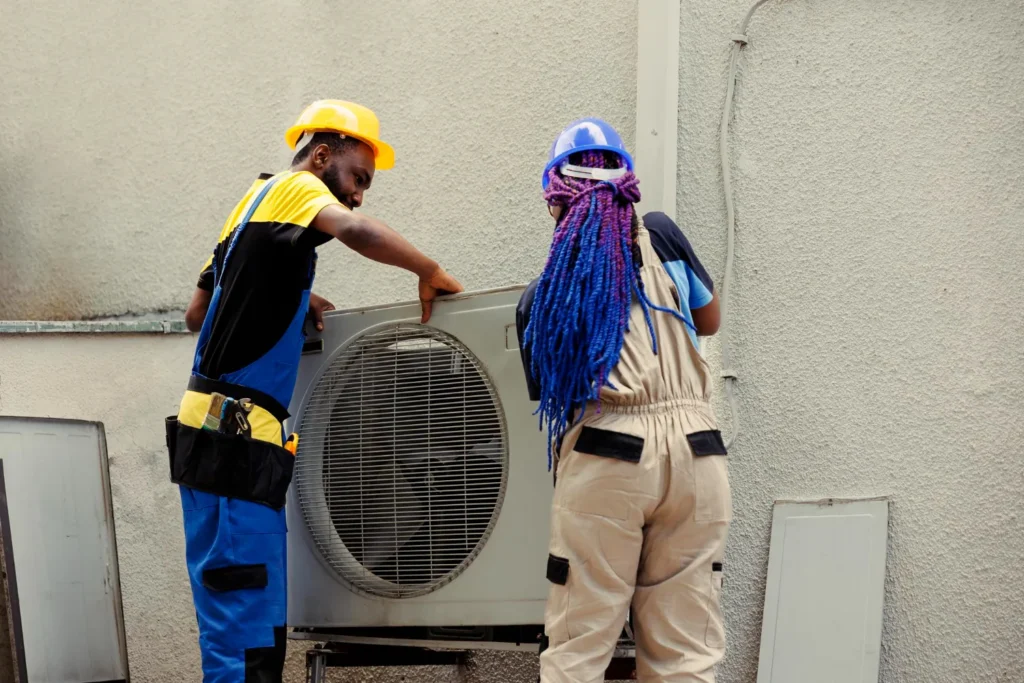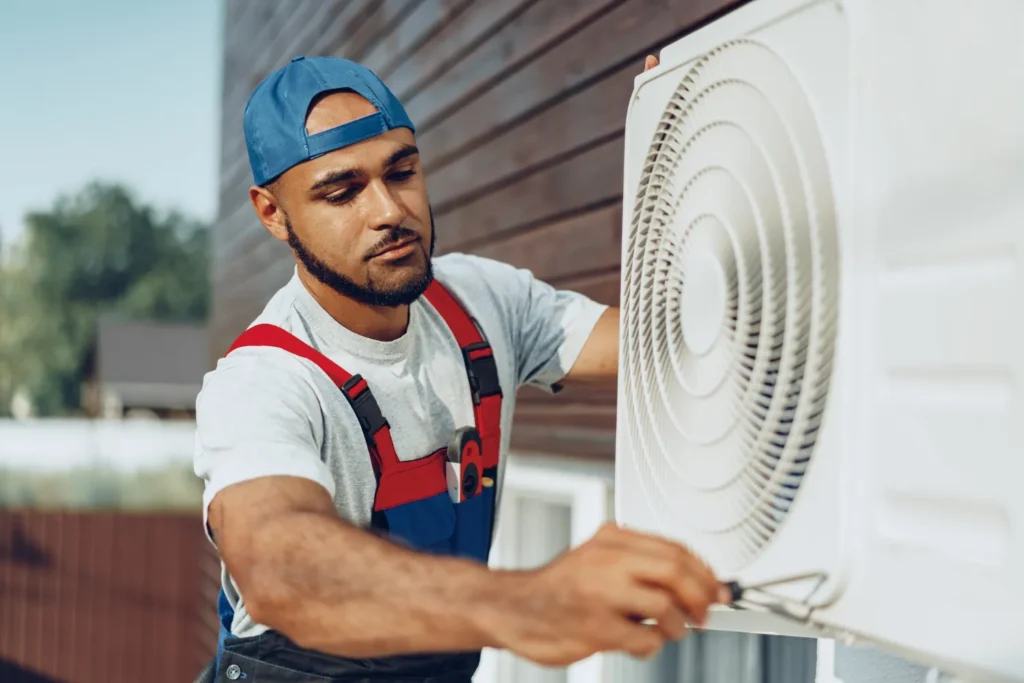Maintaining the efficiency of your air conditioning system is crucial, and a vital component of this maintenance is knowing how to check and replace AC filters. Regularly inspecting and changing your AC filters not only improves the air quality in your home but also enhances the system’s efficiency and longevity. This guide will walk you through the necessary steps to ensure your filters are in top condition, helping you to keep your cooling system running smoothly and efficiently. Let’s dive into the process of checking and replacing your AC filters, ensuring your system remains in optimal working order.
Table of Contents
ToggleKey Takeaways:
- Monthly Check: Regularly check air filters, especially during high-use seasons, to ensure efficiency.
- Proper Cleaning: Disposable filters should be replaced if dirty; pleated filters can be cleaned with water but must be completely dry before reinstalling.
- Filter Location: Know where your filter is located to easily access and maintain it easily; check for directional indicators for proper airflow.
Understanding Your AC Filter Needs To Check and Replace AC Filters

Identifying Your AC Filter Type
One of the first steps in ensuring your air conditioning system runs efficiently is understanding the type of filter it requires. Disposable filters with a cardboard edge are easy to replace if dirty, while higher efficiency 1″ pleated air filters can last up to three months. Different systems may have filters located in various places, such as a removable filter access door in the return air duct next to the furnace or indoor unit, inside the furnace itself, or in a central filter grille installed in a wall or ceiling.
Factors That Influence Filter Change Frequency
The type of filter, indoor air quality, and system usage are factors that can influence how often you should replace AC filters. Some higher-efficiency filters can last longer, but it’s recommended to check and replace them more frequently during peak seasons. It is crucial to follow manufacturer recommendations for optimal performance and air quality.
- Indoor Air Quality: Poorer air quality requires more frequent filter changes to maintain a healthy environment.
- System Usage: Higher usage seasons may require more frequent checks and replacements to ensure proper airflow and efficiency.
Assume that using a low-quality filter or neglecting filter replacement can lead to decreased system efficiency, higher energy bills, and potential damage to the system. Regular maintenance is critical to prolonging the life of your AC system.
How-to Locating Your AC Filter
Little known fact: one of the most important tasks for maintaining your HVAC system is locating and changing the air filter regularly. This simple step can improve the efficiency of your system and prolong its lifespan. With that in mind, let’s examine how you can quickly locate your AC filter in your home.
Common Filter Locations in Home HVAC Systems
A necessary part of maintaining your HVAC system is knowing where to find your air filter. One of the most common locations is in the return air duct next to the furnace or indoor unit. This can be in various places in your home, such as a basement, crawl space, utility closet, garage, or attic. Another common location is inside the furnace itself, next to the blower motor. Additionally, some systems have a central filter grille installed in a wall or ceiling, which swings open to reveal the air filter. Bear in mind that many air filters are directional, with an arrow or airflow symbol indicating the correct airflow direction. Proper installation is critical to ensuring your system operates efficiently.
Tips for Finding Hard-to-Locate Filters
While some filters are easy to locate, others may be more challenging to find. If you need help finding your air filter, consider checking inside the furnace itself or looking for a central filter grille in a wall or ceiling. Remember to look for directional indicators, such as arrows or rougher filter media on one side, to ensure proper installation. Though it may take some time and effort to find your filter, the benefits of a well-maintained HVAC system far outweigh the inconvenience.
- Proper installation is critical to the efficient operation of your HVAC system.
- Regularly changing your air filter can improve system efficiency and lifespan.
- You should also consider seeking professional help if you are still looking for your filter.
Systems are meant to be efficient and reliable, but with proper maintenance, they can become efficient and even dangerous. Remember to regularly check and change your air filter to ensure your HVAC system operates at its best. Your comfort and safety depend on it!
Checking Your AC Filter
After properly locating your AC filter, it’s crucial to check it regularly to ensure your system is running efficiently. Little maintenance steps like this can go a long way in prolonging the life of your HVAC system and improving indoor air quality.
How to Determine If Your Filter Needs Replacement
If you need clarification on whether your filter needs replacing, there are a few key indicators to look out for. Signs of a dirty AC filter can include reduced airflow, increased energy bills, and poor indoor air quality.
Preparation for Replacing AC Filters
Once again, it is essential to regularly check and replace AC filters to ensure optimal performance of your system. Before starting the process, it is crucial to follow some safety tips to prevent any accidents or damage to your equipment.
Safety Tips Before Starting:
- Turn off the thermostat: Before attempting to replace your AC filter, make sure to turn off the thermostat to avoid any potential electrical hazards.
- Locate the filter: Ensure you know where the filter is located in your system to avoid any confusion or delays during the replacement process.
- Use proper tools: Always use the appropriate tools and equipment to remove and replace your AC filter safely.
Any mishap during the replacement process can lead to costly repairs or even pose a threat to your safety. Clearly, following these safety tips will ensure a smooth and safe replacement process.
Tools and Materials You Might Need
Having the necessary tools and materials on hand will make the process much more efficient on your journey to replace AC filters. Typical tools you may need include a screwdriver, utility knife, and possibly a vacuum cleaner to clean any surrounding dust.
Tools can vary depending on the type of filter and your specific HVAC system. Some filters may require specialized tools for removal, so be sure to check your system’s requirements beforehand. Properly equipping yourself with the right tools will prevent any damage to the filter or your system during the replacement process.
How-to Removing the Old AC Filter

All air conditioning systems need regular maintenance to function efficiently. One crucial aspect of this maintenance is checking and replacing the air filters. If you have a disposable type filter with a cardboard edge, it’s critical to know how to remove the old filter safely. Follow the step-by-step guide below to ensure you do it correctly.
Step-by-Step Guide to Safely Remove Your AC Filter
Step 1: Turn off the thermostat to ensure safety.
Step 2: Locate the air filter in your system – usually in the return air duct next to the furnace or indoor unit.
While following these steps, remember to be gentle with the filter to avoid damaging it. A damaged filter won’t effectively filter out air pollutants, impacting your indoor air quality and system efficiency.
How to Dispose of Old Filters Properly
While replacing your air filter is crucial for system performance, it’s also essential to dispose of the old filter properly. For instance, a dirty filter can contain harmful particles and allergens that shouldn’t be released back into the air. Therefore, proper disposal is necessary to prevent contamination.
How-to Installing the New AC Filter
Selecting the Right Filter for Your System
Filter: Despite the various types of air filters available, it is crucial to select a filter that is compatible with your specific HVAC system. Different systems may require different filter sizes and types, so it is essential to carefully read the manufacturer’s recommendations before purchasing a new filter. Higher-efficiency pleated air filters can typically last up to three months before needing replacement, although it is advisable to check more frequently during high-usage seasons.
Step-by-Step Guide to Installing the New Filter
Step 1 – With the thermostat off, locate and remove the old air filter.
Step 2 – Clean the filter using a garden hose with moderate water pressure, being careful not to damage the filter media.
This step-by-step guide provides a straightforward process for safely and efficiently installing a new air filter in your HVAC system. It is crucial to follow these steps carefully to ensure that your system continues to operate effectively and efficiently. By regularly replacing and maintaining your air filters, you can improve indoor air quality and prolong the life of your HVAC system.
Maintenance Tips for AC Filters
Keep air filters in your AC unit clean and well-maintained to ensure optimal performance and efficiency. Regularly checking and replacing filters is crucial to keep your system running smoothly and to avoid costly repairs in the future.
How to Clean Reusable Filters
Little maintenance is required for reusable air filters. Remove the filter and rinse it off with a garden hose, spraying from both sides. Be gentle to avoid damaging the filter media. Let the filter dry completely before reinstalling it. Remember to check the airflow direction and reinsert the filter properly to maintain optimal efficiency.
Schedule for Regular Filter Checks
Tips for maintaining AC filters include checking them monthly, especially during higher-use seasons. Some air filters can last up to three months before replacement, but it’s always better to on the side of caution and check more frequently. Assume that most filters are directional, with airflow indicated by arrows or rougher sides. Pay attention to where the filter is located in your system and follow proper cleaning and replacement procedures accordingly.
Conclusion – Replace AC Filters
On the whole, check and replace AC filters is a crucial maintenance task that should be considered. By regularly inspecting and replacing filters, you can ensure that your HVAC system works efficiently and effectively, improving indoor air quality and reducing energy consumption.
Remember to check your filters monthly, especially during higher-use seasons, and replace them as needed. Knowing where your filter is located and understanding its direction of airflow are imperative steps in this process. By following the steps outlined above, you can keep your HVAC system in top condition and enjoy comfortable, clean air in your home.
FAQ About Replace AC Filters
Why is it important to check and replace AC filters regularly?
It is essential to check and replace AC filters regularly to ensure the efficient operation of your HVAC system. Dirty filters can restrict airflow, leading to decreased efficiency and potential damage to the system.
How often should AC filters be checked?
AC filters should be checked monthly, especially during peak usage seasons. High-efficiency pleated filters may last up to three months before needing replacement.
How do I know if my AC filter needs to be replaced?
If your disposable type filter with a cardboard edge appears dirty, it is time for a replacement. Please do not attempt to clean disposable filters, as they may damage them.
Where can I find the AC filter in my system?
The AC filter is typically located in a removable filter access door in the return air duct next to the furnace or indoor unit. It can also be inside the stove, next to the blower motor, or in a central filter grille installed on a wall or ceiling.
How do I correctly reinstall an AC filter after cleaning?
After cleaning the AC filter with a garden hose, shake off excess water and let it dry completely before reinstalling. Ensure proper airflow direction by following arrows or checking for the rougher side that collects dust.
